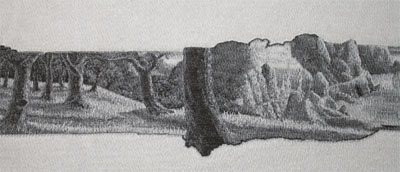
A number of artists have started using textiles and needlework to explore the relationship between computer culture and craft. Here on Rhizome, we've recently covered Ben Fino-Radin, Sabrina Gschwandtner, Cat Mazza, and Cody Trepte, among others employing "traditional media" in the service of a technological critique. Not to be left out of this group is Christy Matson, a Chicago-based artist who takes this investigation to even more self-reflexive heights. Matson's work may not look high tech, but it responds directly to media culture and is often made using a Jacquard Loom, a mechanical device that is important in the proto-history of computing. Many of the artist's projects involve building feedback loops between the sonic experiences of making and viewing her work. Recordings of the weaving process are algorithmically translated into binary yes/no, on/off, or true/false patterns and translated into images in the form of thread color choice, needle behavior, and other factors. The artist includes copper wires in these weavings to act as amplifiers or antennae for further sonic transmissions. See, for example, Movements, in which the viewer's hand is meant to rove as a sort of playhead on what is posited as a 4-channel audio installation. The same questions are raised in her work, Digital Synesthesia, which looks at similarities in the abilities (one might even say tendencies) of both the human brain and the computer to conflate sound and image. To her credit as a dedicated artist, these are issues Matson works to flesh out again and again, even exploiting the repetition of the line-by-line weaving process as an ironic take on the re-spinning of these narratives. When she explored synaesthesia in Soundw(e)ave (a piece whose title conveys her obvious love of word play), she wrote that "This transmutability [between images and sounds] of information in the digital world initially seems to be in opposition to the ways that humans experience the physical world," but is, in fact, quite natural. Speaking of the physical world, her weaving-together of cotton and rayon (or natural and artificial fibers) in Loomscapes seems perhaps her most visually compelling argument of the relationship between traditional media and digital production. Following from the long tradition of tapestries that depict battle scenes and other historical culture clashes, Matson's wall hangings pull landscape imagery from LucasArts' early-90s computer game, LOOM, to collage together images absent of figures, but instead foregrounding the game's beautiful backdrops. In a sense, the beauty and conceptual quandaries that make Matson's work so compelling are nicely summed up in her own words, written about her work, Either/Or: "[This] is a series of work that explores the grey areas that technically should not exist, but often do, in absolute systems." The piece creates what looks to the human eye like a band of grey, where thousands of black and white strings are loosely knotted together. Here, the seemingly hard differences between bodily and machine perception are made messy, but prove worth unraveling. - Marisa Olson
Christy Matson, Loomscapes, 2007


i'm a bit surprised that marisa olson refers to christy matson's digital jacquard weavings as "craft" in her article "weaving shades of binary grey." will textiles ever evolve beyond its step-child's moniker and reach the "art" stage??? i thought modernism was dead.
elyse koren-camarra
roosevelt university
chicago, illinois
stating that art would be a superior stage of craft is condescending
In Olson's lead Matson is described as an "artist using textiles and needlework." You have to read across two sentences but the statement is very clear.
"A number of artists have started using textiles and needlework to explore the relationship between computer culture and craft."
as i read it, it appears that "the relationship between computer culture and "craft"" which i assume refers to the "textiles and needlework" section of the sentence still clumps the media/um as "craft." not to knit-pick or bring up the never-ending dialogue re: art vs. craft, i was just noting how some things really never change, technology-based or not.
ekc
Craft is used as a term of description in the second part of the sentence, not a value judgement, because the first part of the sentence makes it clear we are talking about artists, and therefore art.
Sometimes writers have to use the conventional or cliche meanings of words in order to establish a "base line" to take readers to a new level.
I believe that is what is happening here.
Also in the second sentence "traditional media" is in scare quotes–I took it as implied that "craft" was similarly qualified.
Especially since the whole point of the article was that weaving, etc is seen by artists as an analogue of "high tech" processes.
i have no quibble re: the writer's strategies or intention.
i am having a moment of pause re: craft as a term of description. that aside,
i agree that weaving/technology is seen by the mentioned artists as compatible.
i guess we'll agree to disagree about the "c" term.